

SUSTAINABLE DEVELOPMENT
GOAL 11
Sustainable Cities and Communities
Make cities inclusive, safe, resilient and sustainable
Overview
Sustainable Development Goal 11 is about sustainable cities and communities. Cities are dynamic places that come to life through the opportunities and innovation they offer and where inequality also plays dynamically. The transformation toward resilient and sustainable societies is to bring about a shift in our patterns of production, consumption, managing waste, and redesign cities to be sustainable.
Universities, in this sense, are places of action where various aspects of sustainable cities and communities are debated and, by their nature, are custodians of heritage and environment in their communities.
At Shiv Nadar, we have an active community closely working with many aspects of SDG 11 through teaching, research, institutional practices, and partnerships.
Here is a glimpse of our work.

Teaching and Learning
We are committed to offering meaningful education around sustainability and related areas to all students across the university besides our core subjects. The School of Humanities and Social Sciences offers many courses at the undergraduate, graduate, and doctoral levels. Some of these courses are Archaeology of Cities (HIS 301), Cities of the Global South (INT 131), Pastoral Nomads and the State (HIS 304), Curating Cultures: Collections, Museums and Practices (HIS 305), The Anthropology and History of Experts and Expertise (HIS 315), Archaeology of Landscapes (HIS 317), Seeing the Past: Visual Histories and Archaeological Practices (HIS 323), The City and Urban Perspectives (SOC 416), Field, Archive, Ethnography (SOC 602), Art after WWII (Art and Displacement: Migratory Aesthetics in Contemporary Art) (ART 604). For undergraduate students, many compulsory courses are regularly offered, such as Environmental Studies (CCC 704), Biodiversity: Assessment & Conservation (CCC 706), Environmental Impact Assessment (CCC 406), and Energy for Sustainable Future (CCC 614), Use of Energy in our Daily Life (CCC 624), and Green Energy Technologies (CCC613).
Joint Master of Arts (MA) in Global Urban Sociology in association with the School of Oriental and African Studies (SOAS), London
Shiv Nadar University signed a unique partnership agreement with the School of Oriental and African Studies (SOAS), London, to offer a joint Master of Arts program in Global Urban Sociology. The program is jointly designed, taught, and jointly awarded as a one-year MA between SOAS, the University of London, and the Shiv Nadar University, Delhi NCR. Not only does it give an opportunity to the students to study and experience two premier institutions and two global cities, but it is one of the only programs to focus on global sociology, specifically on the global sociology of cities and urban life-worlds.
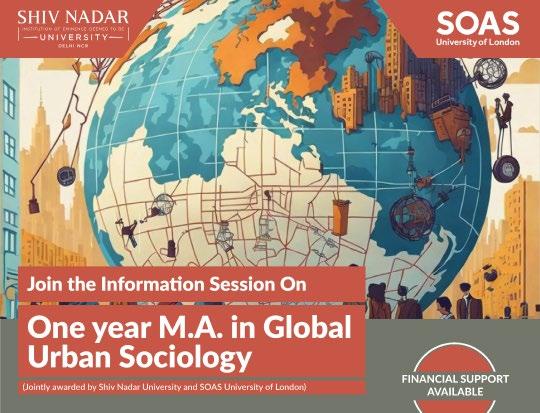
Student Projects
Student-led graduate conference - Regional Histories: Land, Space and Communities
The graduate students of the Department of History and Archaeology organized the third edition of the annual Graduate Conference in March 2023. The theme of the conference was ‘Regional Histories: Land, Space and Communities’.
The conference was a success in taking further the conversation on land and space from the previous two editions of conferences towards an understanding and writing of regional histories. It opened toward the broader theme of regional studies, invoking different temporal and spatial understandings of what constitutes a region. From rethinking the historical understanding of regions by encouraging an interdisciplinary approach, drawing on historical research, literary studies, and historical anthropology, the conference went beyond the limited lens of regional commonalities and region-making to understand interlinked and diverse socio-historical processes such as cultural interactions, trade, travel, pilgrimage, warfare, colonization, and the like.
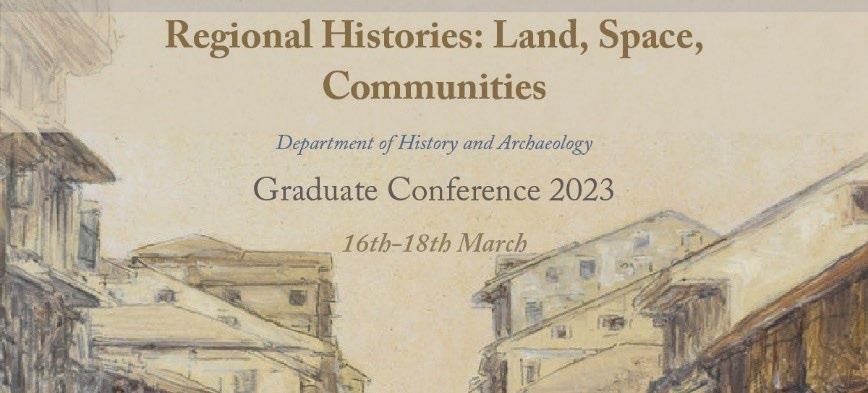
Design and Development of Digital Manipuri Typeface
Ishani Dayal, a student of Design, is working on Meitei Mayek (script/lipid), which is an Indigenous script used to write the Manipuri language. Manipuri had been written in Bengali script for a considerable amount of time in the past. In 2005, an effort was made to replace the Bengali script with Meitei Mayek in all forms of communication. The original Meitei script has recently been adopted to write the Manipuri language. With this change, many typeface designers have either designed or attempted to design Manipuri typefaces for various uses, including fonts for digital devices. Since there is a growing demand for digital devices, a demand for digital font is also growing in the context of digital communication. This project is to design the script for digital use, retaining the aesthetics, value, cultural aspects, and taste connected to the traditional Manipur script. The project addresses the unavailability and issues of digital typefaces in the Meitei script. Her faculty guide on the project is Subhajit Chandra, Assistant Professor, Department of Design.

Social Sector Internship
All undergraduate students in the School of Management and Entrepreneurship undertake a Social Sector Internship (SSI). In this program, students undergo a rigorous 8-week on-site internship immersion in rural and non-urban ecosystems. During their tenure, our students work with local indigenous communities to ameliorate social enterprise challenges or create growth models for the social sector.
Yana Gupta interned with the HCL Foundation on a project titled “Clean Noida Initiative.”
The project revolves around the efficient disposal of waste in collaboration with the Noida authority to reduce litter around the city. This is done to make waste disposal sustainable as well as the journey of waste from the start till the end easier for the community. The project also focuses on capacity building of relevant stakeholders, intensive behavior change campaigns, awareness drives, and technological solutions.
GV Maneesh Reddy interned with Samarthanam Trust for the Blind on “Re-ware (waste management awareness program).”
The project Re-ware of Samarthanam Trust for the Disabled aims to create awareness about waste segregation, reduce carbon emissions, and provide employment opportunities for the rag picker community. Reddy engaged actively in conducting awareness programs, clean-up activities, health sessions, personality development, and financial planning. The project aims to serve nature and the community and improve waste management practices while empowering marginalized communities.
Preeti Katiyar interned with Shiksha Foundation on a project titled, “Dadri Development Project: Assessing the role of technology in improving healthcare in rural communities”.
The project focused on assessing the role of technology in improving healthcare in rural communities, especially Dadri and nearby rural areas.
Shakthi Kumaran interned with HCL Foundation on a project called HCL Uday.
This is HCL Foundation’s flagship urban community development program - UDAY, seeks to create green, clean, healthy and empowered communities. Aligned with the Sustainable Development Goals, it is developing an integrated solution to break the vicious cycle of urban poverty.

First Archaeology Day held on campus Research
Shiv Nadar University has one of very few undergraduate programs in History and Archaeology. To showcase these strengths, Chronos: The Archaeology Day was held on October 14, 2023. This was an initiative by Mnemon, the History and Archaeology Society, which offered high school students an opportunity to explore the field of Archaeology in a fun and interactive manner. The aim was to provide a platform for those interested in pursuing higher studies in the discipline of archaeology, to explore its close connections with history and science, and to meet experts from the field. The daylong event saw close to 50 students (grades 9 -12) from different schools across Delhi-NCR participating.
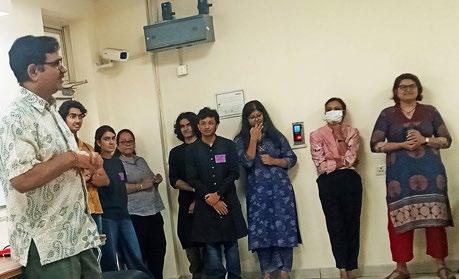
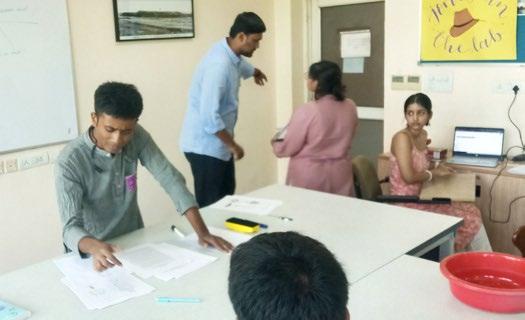

Research
The Department of History and Archaeology
The Department of History and Archaeology offers a unique and creative intertwining of history, archaeology, and museum studies as distinct disciplinary approaches to the past. With a strong focus on research, the faculty has invested in expanding the frontiers of scholarship in history and archaeology. The Department has an Archaeology Lab that aims to bring together scholars from a number of universities and institutions in India and outside to collaborate in research and provide training and skills for archaeological methods, as well as exposure to related aspects, such as museum displays, curation, content generation, and heritage studies. The lab contains an interesting collection of artifacts and is popular as a space to introduce students to important field methods and offer resources for intensive study.
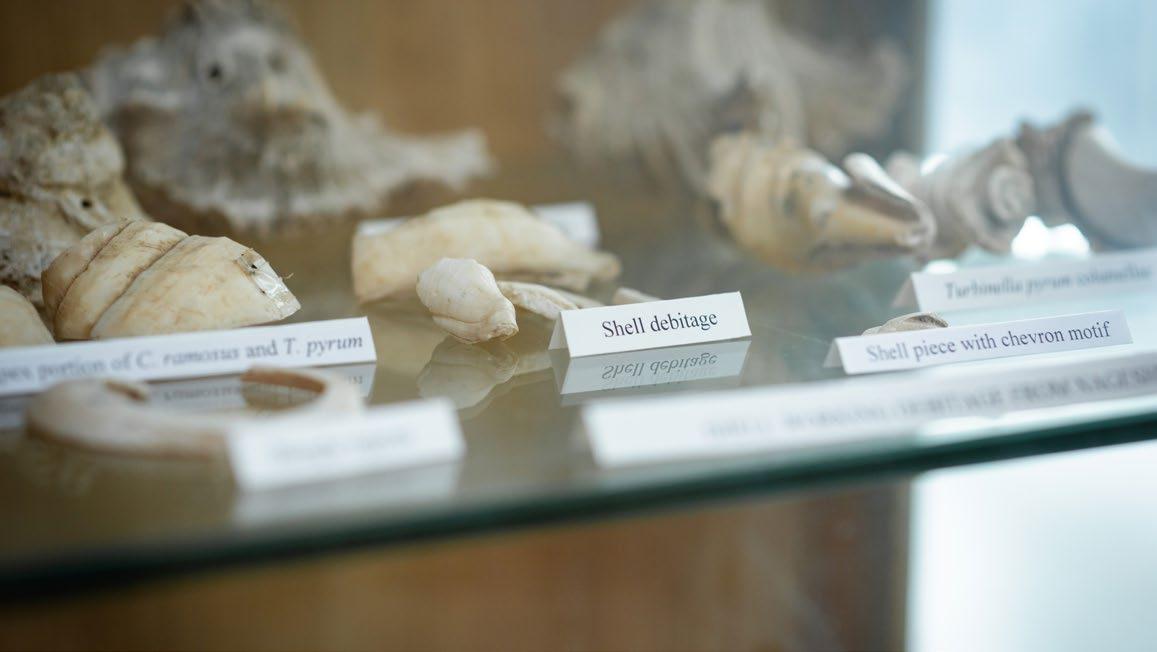
Folk genre of rural community women: Patrons in the preservation of folklore
Dr. Tulika Chandra, Professor, Department of English, is doing empirical research that employs oral folk expressions carried on for generations by the women in Gautam Budh Nagar villages. The research project is recording, preserving, and disseminating digitally the ancient tradition, giving it stability and continuity. The research locates the changes in the folk forms and expressions due to urbanization and the impact of the fast-growing cities on these women’s voices. The stimulating research involves identifying women’s voices and their imaginative power in folk forms and their controlling images in contrast with the male-dominated influence. Traditionally, storytelling is thought to be a significant medium to preserve the culture of a civilization, to explain natural phenomena, to transmit historical and important social information, or to teach important moral and ethical issues.
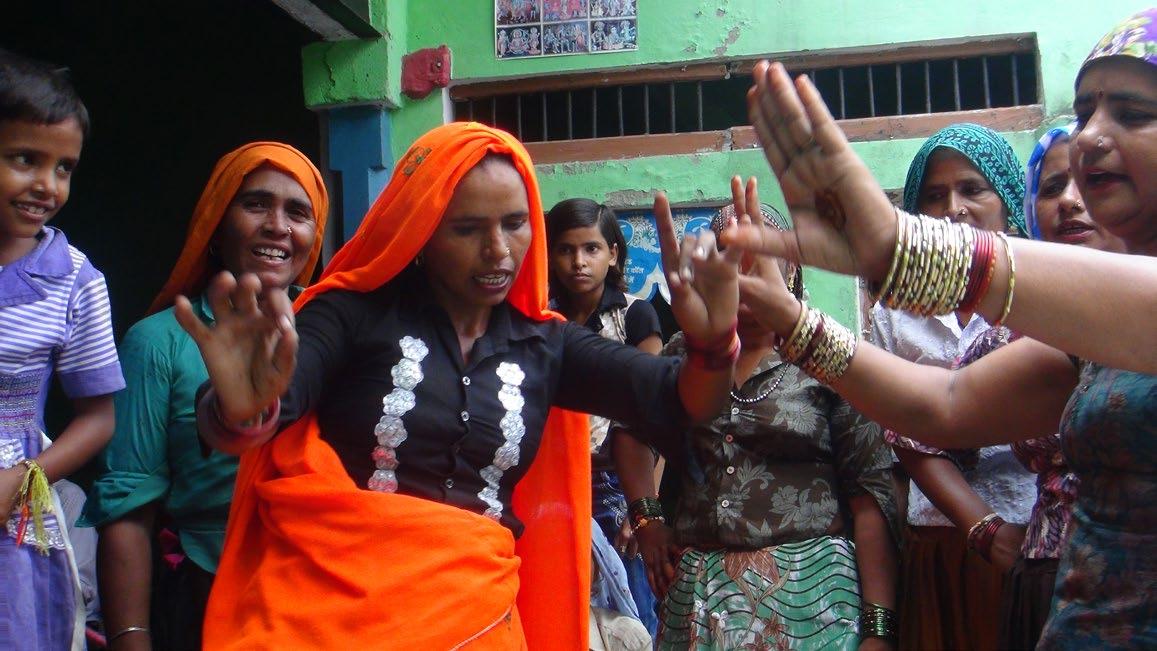
Analyzing driving factors of India’s transportation sector CO2 emissions: Based on LMDI decomposition method
India is the world’s third-largest carbon dioxide (CO2) emitter, with the transportation sector accounting for most of this emission. Using the logarithmic-mean Divisia index (LMDI) decomposition method and Tapio decoupling, this study examines the driving factors and their relationship with economic growth for the Indian transportation sector. The increasing demand for vehicles, reliance on conventional fuel, and increase in energy consumption indicate a positive correlation with the increase in the nation’s CO2 emissions. In contrast, the transition from coal to electric locomotives and the increased use of electric vehicles offset the increase in emissions. In short, the government should update strategic sustainable transport policy measures and emphasize renewable energy. This study will assist policymakers in formulating robust sustainable transportation policies.
Jain, Siddharth, and Shalini Rankavat. “Analysing driving factors of India’s transportation sector CO2 emissions: Based on LMDI decomposition method.” Heliyon 9, no. 9 (2023).
Study of COVID-19 impact on users’ perception of transport modes choice in India
The COVID-19 pandemic has adversely affected the transportation sector, leading to a change in travel behavior. One of the most important responses of countries worldwide to slow the spread of the pandemic has been to restrict the movement of people, which has had a considerable effect on transport systems and is likely to affect the modal choices of commuters. The social and economic effects of the COVID-19 epidemic on public transportation encompass service performance and health risks to social equity, financial viability, and sustainable mobility. To assess the likely nature of such a shift, this study attempts to understand mode choice based on the perception of commuters for their work and non-work trips after the lockdown phase due to COVID-19. The study provides results for future transportation policies in the post-COVID period.
Rankavat, Shalini, Ananya Reddy Gurram, Digvijay S. Pawar, and Vivek Kushwaha. “Study of COVID-19 impact on users’ perception for transport modes choice in India.” Iatss Research 47, no. 1 (2023): 73-83.
Baseline Design of Propeller for an eVTOL Aircraft to Achieve Urban Air Mobility
Urban Air Mobility (UAM) has gained traction in the aviation industry. With the ever-increasing rate of urbanization, congested roads have become a common phenomenon in megacities across the world. Urban Air Mobility in the form of Electric Vertical Take-off and Landing (VTOL) aircraft presents an opportunity to revolutionize the transportation sector by providing sustainable intercity and intracity travel for urban dwellers. Amongst the different eVTOL configurations, the tilt-rotor and hybrid lift + cruise configuration aim to combine the advantages of fixed-wing and rotary-wing aircraft. The presented work aims to develop a detailed design procedure for the propellers of a tilt-rotor eVTOL aircraft to maintain low noise emission and to have high efficiency to utilize the capacity of current battery technology to the maximum extent. The outcome of the work is the theoretical dimensions and geometry of the propellers, which provide the required thrust, efficiency, and low noise emission for the considered eVTOL aircraft.
Faraaz, Mohammed, Afreed Faizan, Mukunda Badarinath, Kiwin Vignesh Subramaniyan, Dineshkumar Harursampath, and Ramesh Burela Gupta. “Baseline Design of Propeller for an eVTOL Aircraft to Achieve Urban Air Mobility.” In 2023 IEEE Aerospace Conference, pp. 1-10. IEEE, 2023.
Earth observations for urban policies and future pathways for urban environmental research
Urban research is evolving, and there are several challenges that need to be addressed, which has led to pathways for further development. The scientific community must consider a multitude of options for urban monitoring, evaluation, planning, and management. In this chapter, the authors provide a brief overview of different models for urban studies and research based on Earth observation datasets. The chapter discusses a variety of potential research areas, including satellite-based monitoring of urban areas, IoT and cloud computing in urban management, and the use of machine learning in urban environmental research. In addition to digitization, the availability of big data sets, machine learning (ML), and artificial intelligence (AI) will revolutionize the way urban areas are analyzed and planned, opening up new possibilities for sustainable urban challenges. The chapter outlines qualitative and quantitative methods utilizing predictive models and scenario analysis for identifying and implementing urban environmental policies. The recommendations provided in this chapter can be used for further urban studies, research, and the development of smart and resilient cities.
Ekka, Pawan, Manjari Upreti, Purabi Saikia, Amit Kumar, Prem C. Pandey, and Prashant K. Srivastava. “Earth observations for urban policies and future pathways for urban environmental research.” In Earth Observation in Urban Monitoring, pp. 375-387. Elsevier, 2024.
Earth observation applications for urban mapping and monitoring: research prospects, opportunities and challenges
The significant loss of urban green spaces led to increasing Urban Heat Island (UHI) effects, environmental pollution, and other factors that have made it more difficult for societies to create healthier living conditions. The first-generation Earth Observation (EO) data like MODIS500 and GlobCover300 had less to moderate spectral and spatial resolution having limitations in the precise mapping of urban environmental variables. Monitoring and evaluating the urban environment have improved with the advancement of EO like GlobeCover30 and the Global Human Settlement Layer, which are connected to a multisensory approach, Unmanned Aerial Vehicles (UAVs) - LIDAR for 3D mapping, as well as microwave SAR applications. This chapter offers an overview of interesting facets of urban area research that use EO datasets directly or indirectly to address the complexity present in the urban environment for mapping and monitoring. It offers potential future directions for creating a sustainable urban environment. It includes some case studies that demonstrate the potential of EO in mapping and monitoring urban areas, land use/land cover changes, air pollution, site suitability, road safety, urban flood monitoring, and UHI effects.
Chauhan, Aashri, Md Wasim, Smrutisikha Mohanty, Prem C. Pandey, Manish Pandey, Neeraj K. Maurya, Shalini Rankavat, and Surya Bhushan Dubey. “Earth observation applications for urban mapping and monitoring: research prospects, opportunities and challenges.” Earth Observation in Urban Monitoring (2024): 197-229.
Various Perspectives on Occurrence, Sources, Measurement Techniques, Transport, and Insights Into Future Scope for Research of Atmospheric Microplastics
Microplastics in the environment have been recognized as emerging contaminants due to rising concerns over their significant adverse effects on humans, animals, aquatic life, and many other ecosystems. Although their presence and associated implications in the water and soil have been studied substantially, comparatively less studies have been conducted on atmospheric or airborne microplastics. This chapter has synthesized knowledgebased information from recent studies conducted on various aspects of atmospheric microplastics in a systematic manner. The synthesis of knowledge includes classification, properties, occurrence, responsible emission, sampling techniques, quantification, factors affecting concentration, transport after emitted from sources, prediction of fate, and control technology of atmospheric microplastics. The challenges in various aspects, from climate change to future research, are addressed. The influencing parameters for concentrations of microplastics in the air medium are lifestyle choices of communities, other man-made activities, and meteorological factors.
Behera, Sailesh N., Mudit Yadav, Vishnu Kumar, and Prangya Ranjan Rout. “Various Perspectives on Occurrence, Sources, Measurement Techniques, Transport, and Insights Into Future Scope for Research of Atmospheric Microplastics.” Microconstituents in the Environment: Occurrence, Fate, Removal and Management (2023): 203-225.
Assessment of urban flood susceptibility and role of urban green space (UGS) on flooding susceptibility using GIS-based probabilistic models
With rapid urbanization, the green space in urban areas is replaced with impervious built-up areas, which increases the frequency of urban floods. Kamrup Metropolitan District, Assam, is near the Brahmaputra and is highly prone to urban flooding. The present study aims to develop the urban flood susceptibility index (FSI) and to analyze the role of urban green space (UGS) as a nature-based solution (NBS) for urban flood susceptibility. Two types of flooded urban areas are observed using a two-stage cluster analysis. A GIS-based urban FSI is developed using logistic regression (LR), frequency ratio (FR), Shannon entropy (SE), certainty factor (CF), and weight of evidence (WoE) models, and variation of FSI is assessed for different UGS areas. According to the area under curve (AUC), the performance of all five models falls under the good to excellent class. The average UGS ratio for non-flooded is higher than for flooded areas, and with an increase in the area of UGS, the flooding probability decreases for all the models. The findings of the present study emphasize the importance of UGS and can be used for effective urban flood risk mitigation and management planning
Gupta, Laxmi, and Jagabandhu Dixit. “Assessment of urban flood susceptibility and role of urban green space (UGS) on flooding susceptibility using GIS-based probabilistic models.” Environmental Monitoring and Assessment 195, no. 12 (2023): 1518.
Seismic risk assessment for the Northeastern Region of India by integrating seismic hazard and social vulnerability
The study is about conducting a comprehensive seismic risk assessment for the Northeastern Region of India at regional and sub-regional levels by integrating probabilistic seismic hazard and social vulnerability assessments. Bedrock-level peak ground acceleration varied from 0.14 to 0.69g for the return period of 475 years. Using PCA, the social vulnerability index (SVI) was generated considering district-level socioeconomic indicators. Built environment quality, illiteracy, access to amenities, dependent population, and employment opportunities contributed to high SVI. Most vulnerable districts were concentrated in the Brahmaputra floodplains, Tripura fold belt, and Imphal valley. At the regional level, significant parts of Assam, Meghalaya, Arunachal Pradesh, and Tripura lie in moderate to very high-risk zones. At the sub-regional level, Nagaland accounts for the highest proportion of areas in high to very high-risk zones. The findings will aid site-specific resilient infrastructure design, disaster risk reduction, and effective resource allocation for the risk-prone areas.
Agrawal, Navdeep, Laxmi Gupta, Jagabandhu Dixit, and Sujit Kumar Dash. “Seismic risk assessment for the North Eastern Region of India by integrating seismic hazard and social vulnerability.” Sustainable and Resilient Infrastructure 8, no. sup1 (2023): 102-132.
Water Stories: River Goddesses, Ancestral Rites, and Climate Crisis
Atul Bhalla, Professor, Department of Art, Media and Performance, was a participating artist in “Water Stories: River Goddesses, Ancestral Rites, and Climate Crisis” at the Radcliffe Institute for Advanced Study, Harvard University.
The exhibition ran from September 18 to December 16, 2023, and presented artworks that tell alternative stories of water experiences in the context of climate change. The event juxtaposes older, traditional paintings depicting myths with works by contemporary artists that evoke aesthetic experiences of water in the age of climate crisis.
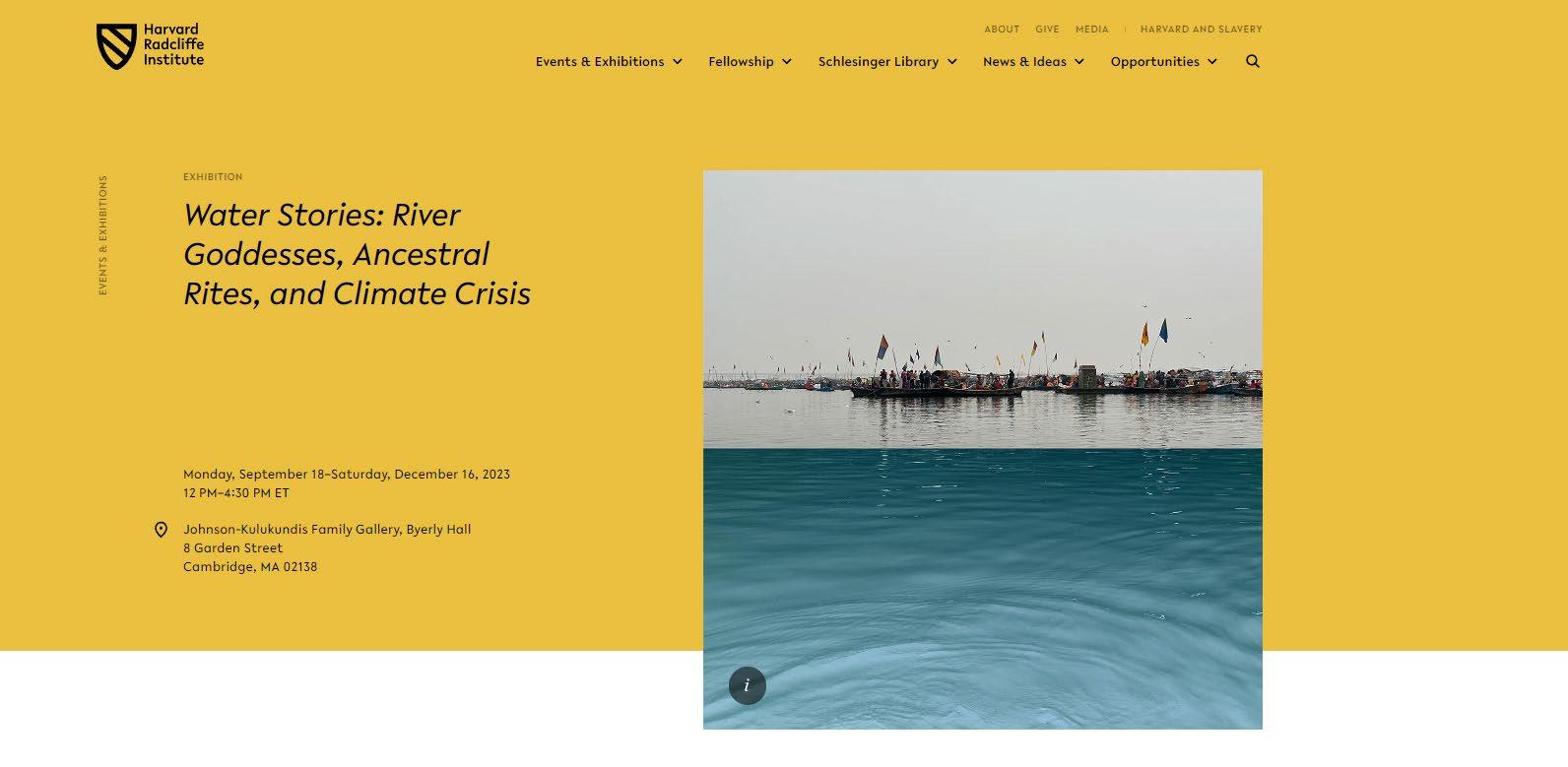
Conversations on Campus

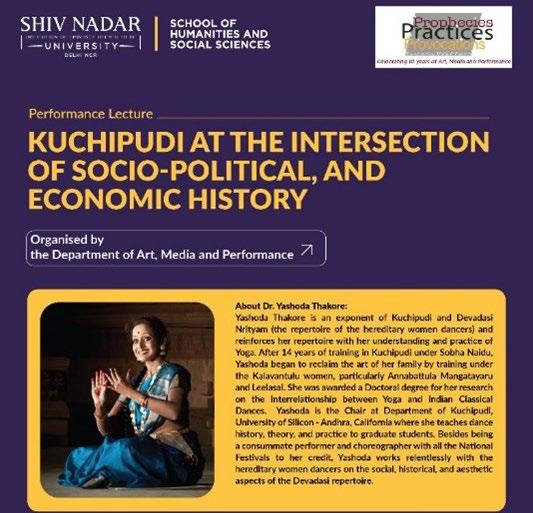
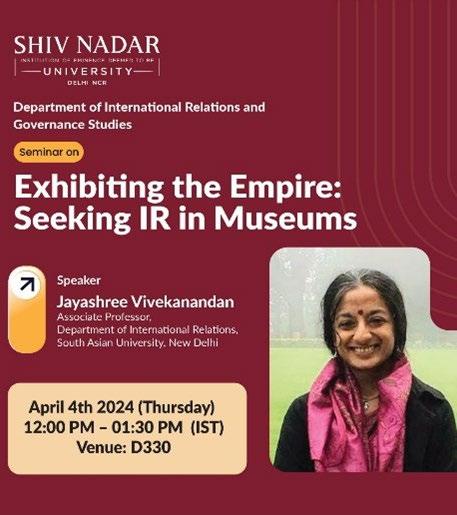
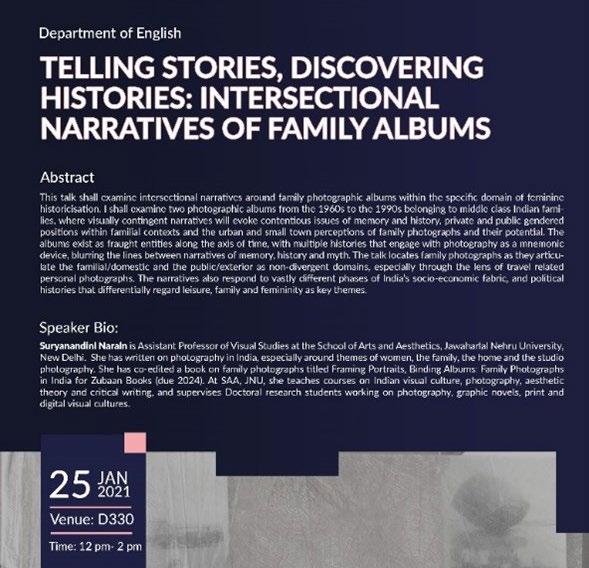
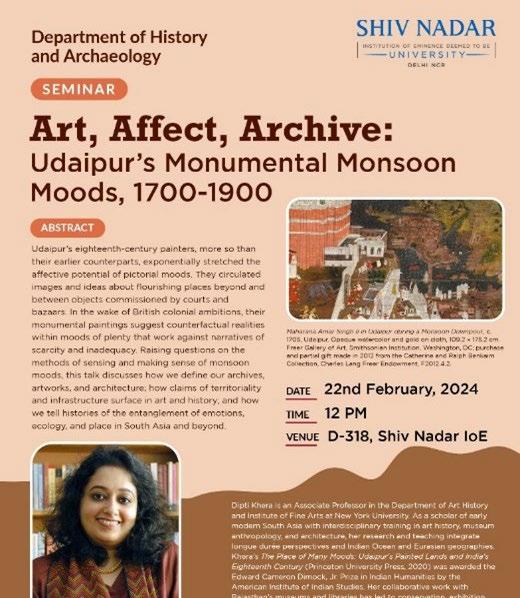
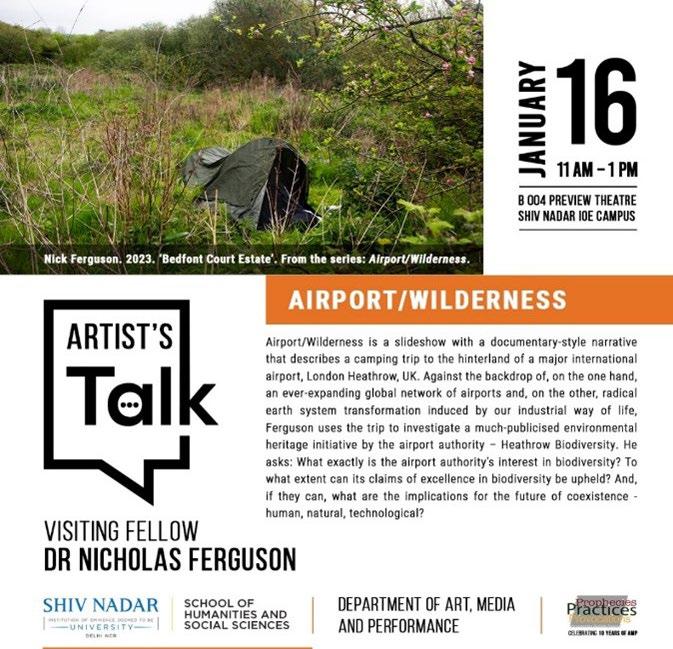
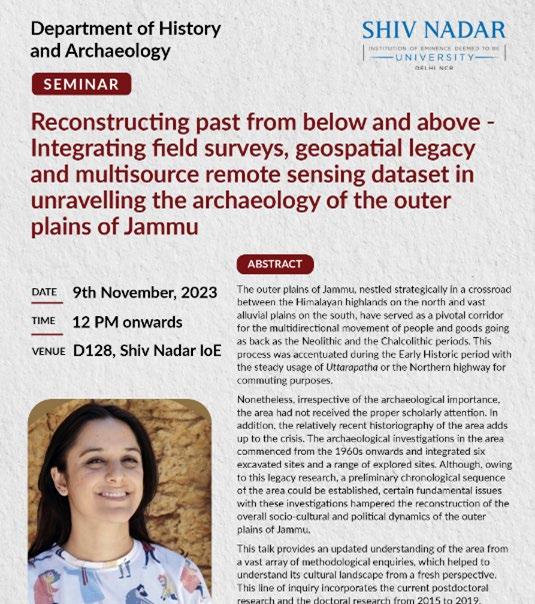
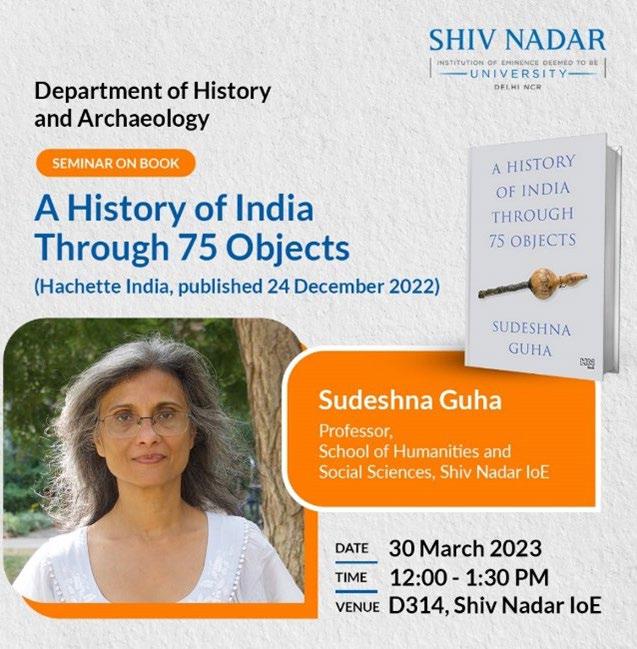
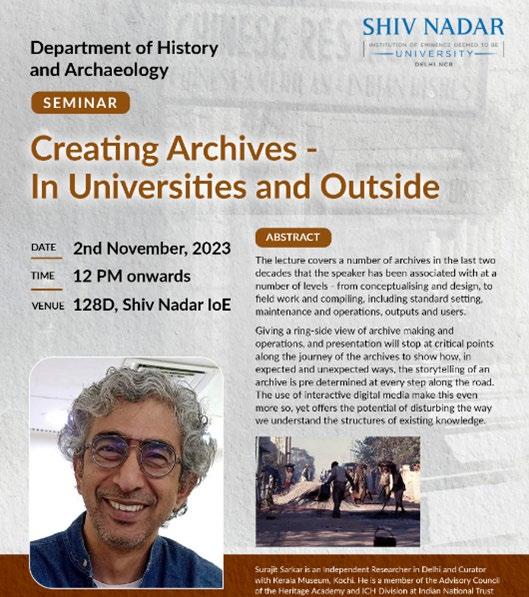
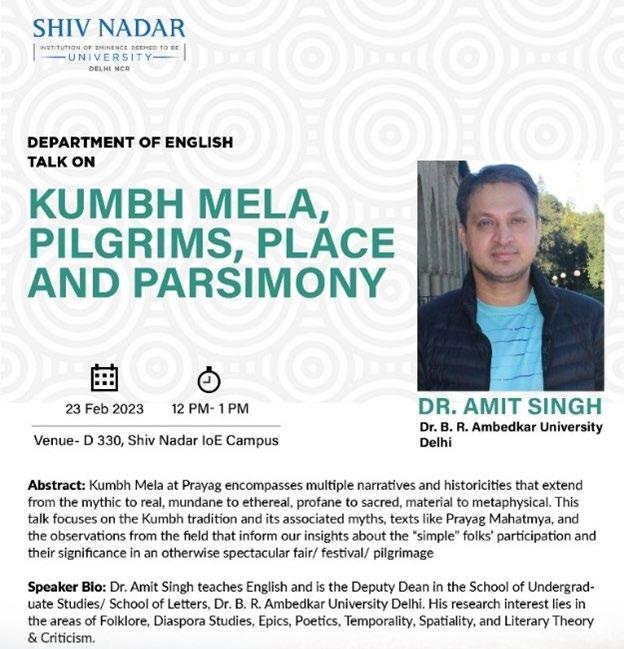
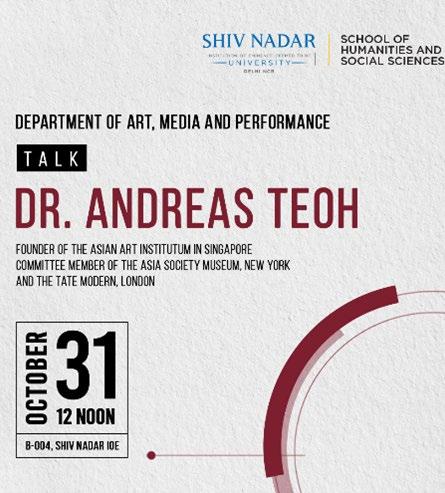
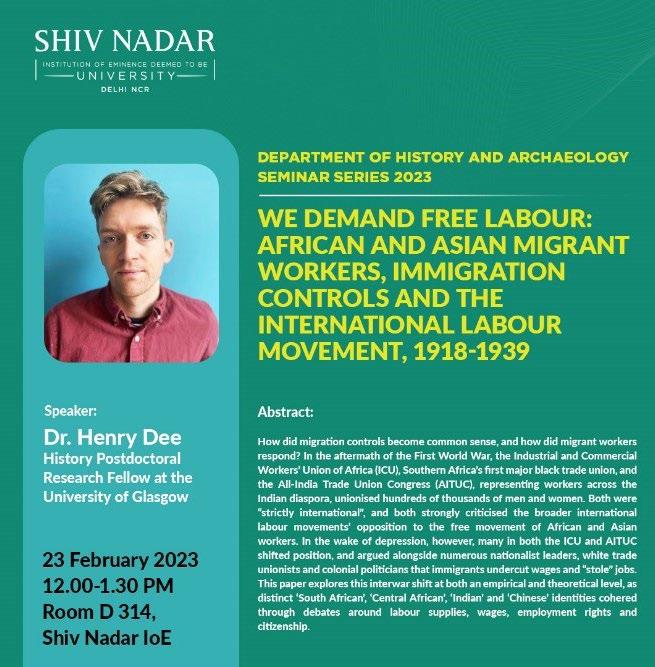
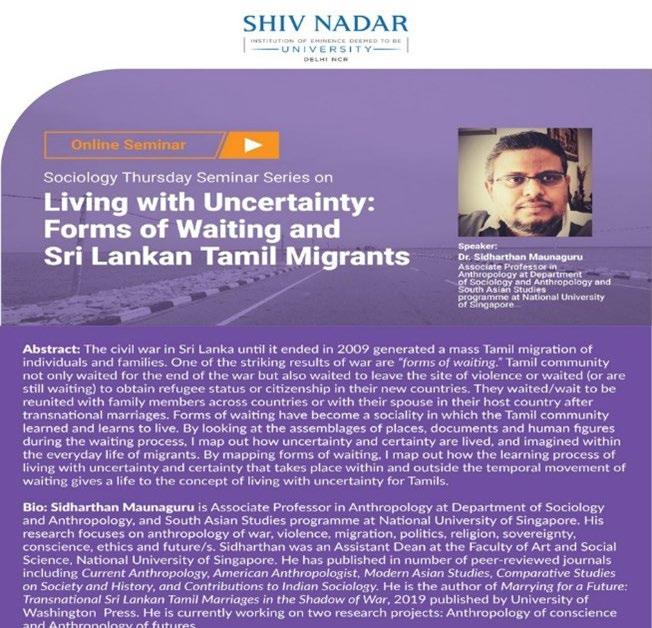
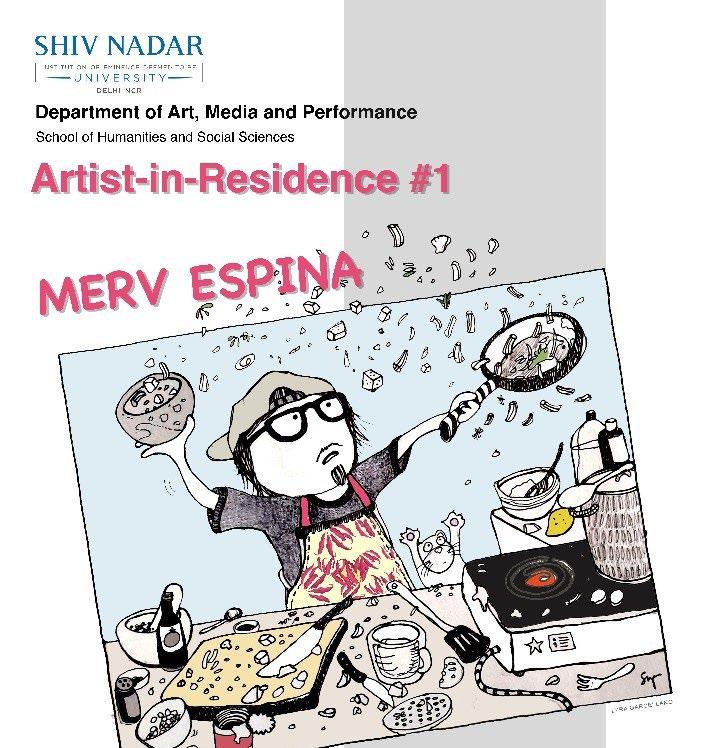
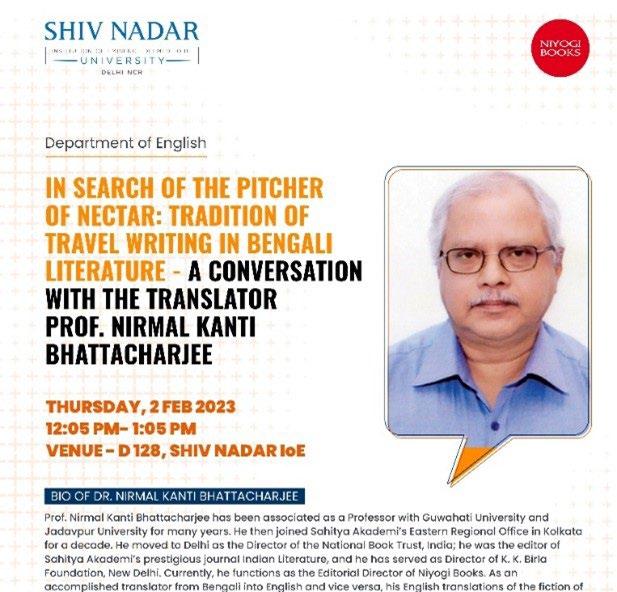
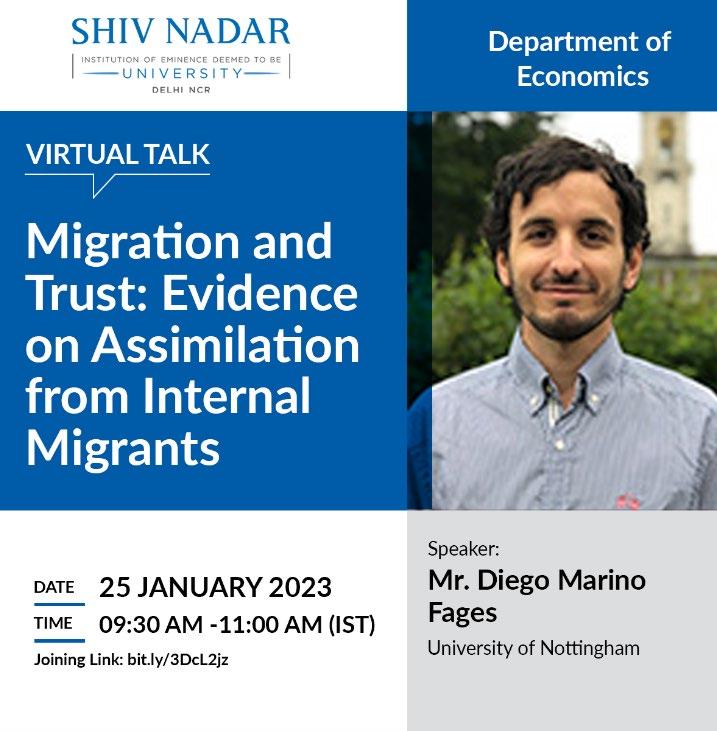
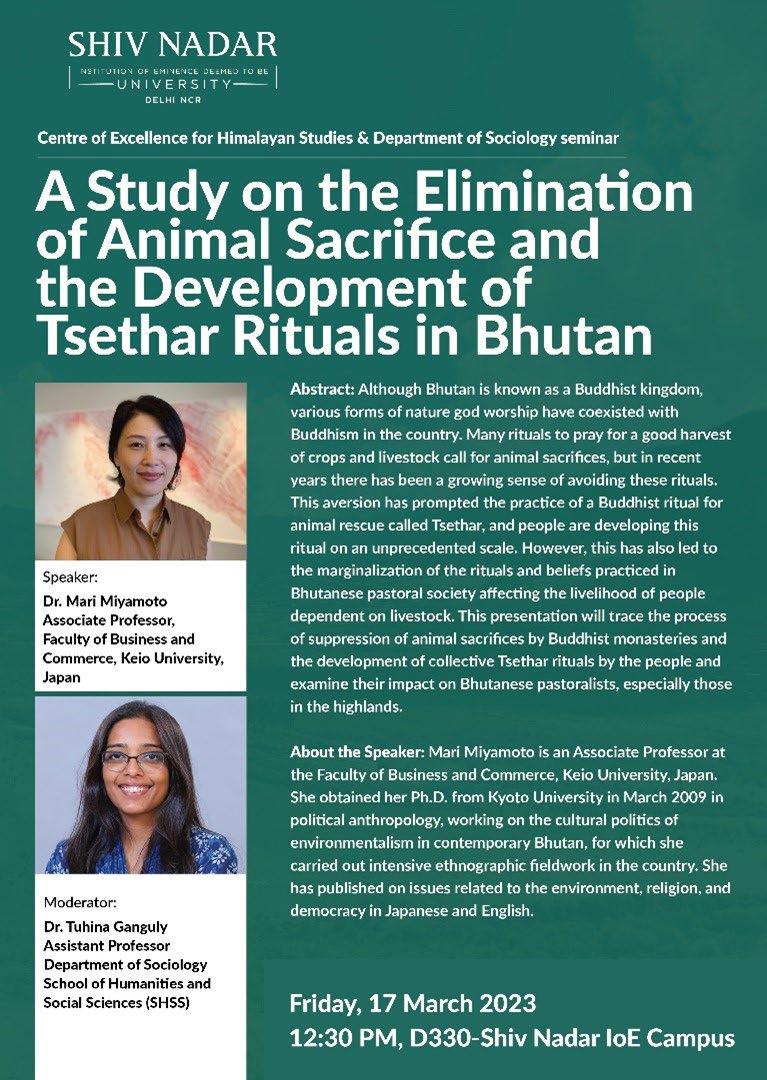
Folk Art Can Be a Powerful Tool for Explaining Biodiversity- featured in Scientific American
Folk art can be a powerful tool for communicating complex scientific ideas. At Shiv Nadar University, a team of faculty, staff, and students has created a unique map to visually communicate the rich flora and fauna of campus using the traditional art form. Conceptualized by Dr. Bahar Dutt, Associate Professor, Department of Art, Media and Performance, and created by artist Sudarshan Shaw, who used folk art to create a biodiversity map. This map was featured in Scientific American, capturing the richness of the campus biodiversity using Indian folk art and bringing together disciplines of Ecology, Communications, and Art. Created using Mughal-style art, the map depicts the university’s faunal diversity, including ten species of mammals, 65 species of birds, nine species of reptiles, five species of amphibians, and 27 species of Butterflies in and around the campus. The map is installed all over campus to educate and create a sense of pride in the university’s ecosystem, which is more than the built environment.
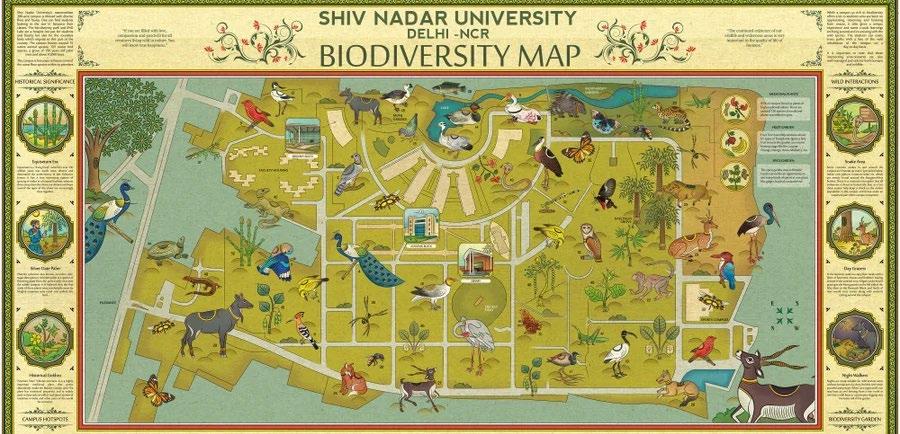
University Operations
We have undertaken many institutional practices that have contributed to achieving sustainable communities and cities. Some of these are listed here.
Sustainable Commuting
Students and most of our faculty stay on campus. A well-planned transport system is in place for those who travel to work and for weekly needs. Within the campus, students and staff use bicycles to commute. We are committed to transitioning 50% of the car fleet to electric vehicles. The University currently has 60% CNG, 30% petrol, and 10% diesel cars.
Shuttle Services
The university provides transport services for students and all staff members to facilitate travel to the city and neighboring places on weekends. The service is planned and managed by the student transport committee for students with the support of administration.
Sustainable Housing
The university offers quality campus life and an invigorating experience. We have thoughtfully designed apartments, accessible amenities, state-ofthe-art sports infrastructure, and other conveniences. There are various clubs and societies where one can pursue hobbies and interests.
Shiv Nadar is a fully residential campus, and all students stay in state-of-the-art student hostels. They are designed to cater to individual student requirements for personal space while also incorporating a culture of shared living. The University environment is ideal for learning and self-discovery. With students from 28 states, the university is a microcosm of India that reflects the country’s diversity in culture, talent, and perspectives.
Sustainable Buildings
At Shiv Nadar, all buildings are certified by the Indian Green Building Council (IGBC) or Leadership in Energy and Environmental Design (LEED). Several buildings, including the 120,000 square ft. sports complex, are LEED Gold certified. The main features of these buildings include energy efficiency, renewable energy generation, water efficiency, stormwater management, and a superior indoor environment.
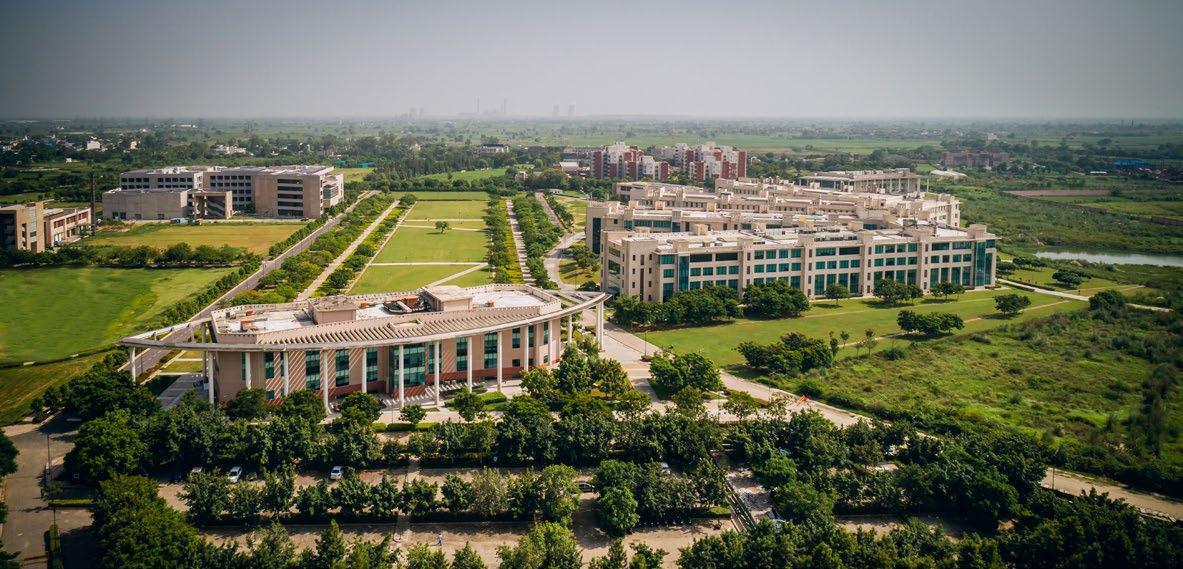
Partnerships
Inter-institutional collaborative grant
The Shiv Nadar Foundation launched an inter-institutional collaborative grant, a first-of-its-kind initiative with a grant of INR 40,00,000 each for the selected proposals. The idea behind the grant is to promote the spirit of collaborative research among the member entities of the Shiv Nadar Foundation. One of the projects to get selected from Shiv Nadar University is “The Past as Present: Approaches to Pedagogy, History, and Archaeology. This interesting project will be a collaborative effort of Shiv Nadar University, Delhi NCR | Vidyagyan School, Bulandshahar | Shiv Nadar School, Noida Team Shiv Nadar University, Delhi NC.
Shiv Nadar IoE has signed a Memorandum of Understanding (MoU) with the Kala Chaupal Trust to explore avenues to work on the culture and heritage of Bulandshahr, art, and nature conservation. We are working on several projects to capture the district’s ancient, medieval, and modern stories and narratives. The documentation and on-ground action will support heritage and create a sustainable model for cultural tourism. The collaboration includes student internships, faculty research collaboration in Kala Chaupal’s projects, nature walks, heritage works, and publications.
The Kala Chaupal Trust
Community Initiatives - Dadri Development Program (DDP)
Shiv Nadar University, in collaboration with the Shiv Nadar Foundation, conducts many community-focused programs focusing largely on education (school /community sports), healthcare, skilling and livelihood, agriculture, social safety (with a particular emphasis on women), and nature conservation.
This year, we launched two dedicated interventions across eight villages of Dadri. These were as follows:
Non-communicable Diseases (NCD) Awareness Campaigns:
The Dadri Development Program (DDP) team, along with onboarded NGOs, implemented community-based intervention for improving health outcomes in 8 villages of Dadri, Uttar Pradesh. Eighty awareness camps on non-communicable diseases (NCD) were organized in 8 interventions in villages in Dadri, targeting prevalent NCDs like stroke, cancer, COPD, cardiac health, and diabetes. This initiative directly benefitted 3,922 community members and had a broader impact on a population of over 26,000.
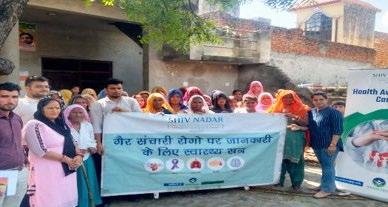
Health Chaupal:
Designed to raise awareness about six critical health conditions, namely women’s health, diabetes, cardiac health and hypertension, orthopedics, dental issues, and eye care. The DDP team and NGO partners conducted 48 Health Chaupals, focusing on crucial healthcare areas such as diabetes, cardiac health, cancer, orthopedics, eye care, and dental care. These sessions, led by specialist doctors, attracted 3,811 community members. Diagnostic blood tests were conducted for 2,828 community members in the eight intervention villages.
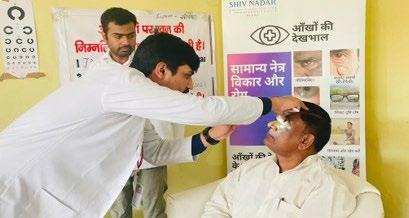
Shiv Nadar Institution of Eminence is fully committed to the UN Sustainable Development Goals (SDGs). We have embraced a four-pronged strategy for SDGs through teaching, research, our core institutional practices, and partnerships.
Deepa Hazrati
Sr. Manager, Office of the Vice-Chancellor
deepa.hazrati@snu.edu.in
Shiv Nadar Institution of Eminence
Gautam Buddha Nagar, Uttar Pradesh, India www.snu.edu.in/home
